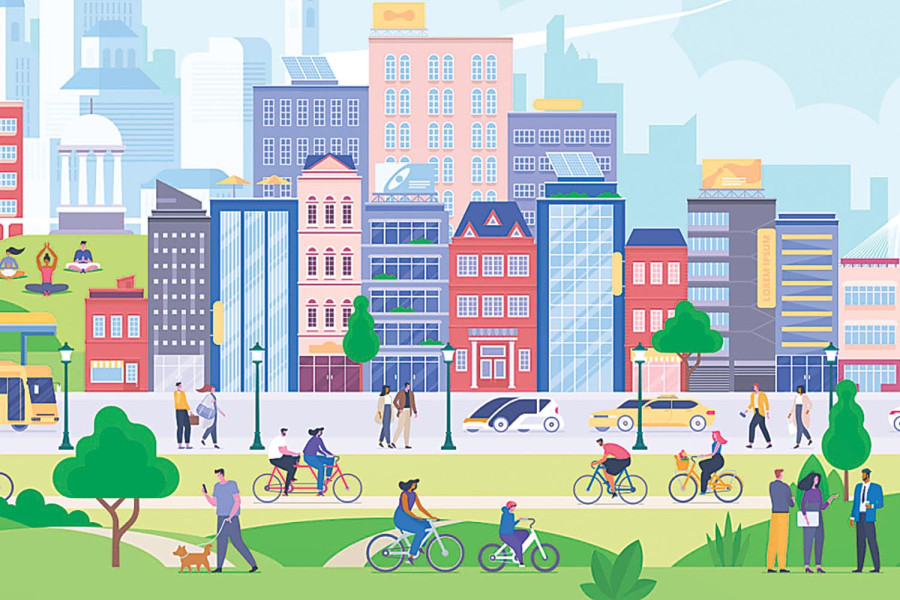Columns
For a smart and sustainable city
It involves balancing the needs of people and the environment while maximising data utilisation and technology.
Rojan Baniya
Smart technologies are a daily necessity in our era, with two global trends as frontrunners—sustainability and technology. So smart and eco-cities are the new buzzwords, especially when discussing urban futures. Neighbours India and China have taken significant steps, capitalising on these trends with “Smart Cities Mission” and “All-In-One Project”, respectively. Interestingly, their approaches differ: While the Indian mission embraces smartness manifested in ICT and new technology, the Chinese project tilts toward ecological civilisation. Nepal stands to make the best of both by integrating sustainable and technological smartness into urban development. And Kathmandu Valley, being the nation’s economic and cultural capital as well as tourism gateway, can be the starting point.
Turning the valley into a smart and sustainable place entails balancing its people, environment, and profit with optimal data utilisation and technological advancement. This helps enhance the quality of life in terms of health, mobility, energy, participation, data, safety and inclusivity. The goal should be to make Kathmandu Valley livable, healthy and enjoyable for its residents, attractive to businesses, and hospitable to global visitors. This can be achieved by adopting four interconnected goals the European Union (EU) incorporated as the cornerstone of smart tourism: Accessibility, sustainability, digitalisation, and cultural heritage and creativity. Every year, European cities compete to be Europe’s smart capital cities. Pafos (Cyprus) and Seville (Spain) won the 2023 European Capital of Smart Tourism by excelling in these four areas. The valley can also adopt this framework with proper contextualisation.
Improving accessibility
Smart mobility, consisting of intelligent transport and mobility networks, can make Kathmandu Valley physically and digitally accessible to its residents and visitors. It delivers choices for various modes of transportation, such as motor vehicles, electric vehicles, self-directed vehicles, public transport, scooters, and on-demand ride-sharing services, including Pathao and InDriver. The valley can adopt a platform like MaaS (Mobility as a Service) that amalgamates numerous transportation and transport-related services into a single, all-inclusive and on-demand mobility package. Some European cities employ this to make travel easier for their residents. Similarly, in downtown Denver, residents do not need personal rides, as the city offers visitors free trolly rides from one end to another, letting them in and out of key areas. Durbar squares in the valley can envision similar innovative services.
Smart Kathmandu Valley’s second aspect is accessibility in the language and digital sphere. In Seattle, the OpenSidewalks Project has initiated AccessMap, a trip-planning tool that assists individuals with limited mobility. The valley should be effortlessly accessible to tourists and citizens in terms of language and the digital sphere, irrespective of their language, cultural background and physical abilities. Multilingual Social Media, GPS and Virtual Reality are vital in building such a system.
Focusing on sustainability
The world accepts Sustainable Development Goals (SDGs) as the development theme, and cities have a critical role in achieving them. Since a smart city coexists with nature, Kathmandu Valley should manage its natural assets by reducing the environmental impacts in development, and involving local communities for environmental sustainability. Moreover, it can benefit from sustainable urban planning, waste management, energy efficiency and water management. In New York, landlords offer apartments for rent only if tenants are willing to segregate their waste into separate bins, which city officials can later process. Several initiatives can be taken with the model—reduce, reuse, recycle and repurpose. Copenhagen, often ranked as the greenest city on the planet, has built super cycle highways, leading to 45 percent of city residents commuting daily by bike. The valley can develop a similar approach towards cleanliness and climate.
Towards digitalisation
Digitalisation enhances the everyday experience of residents and tourists, enabling straightforward access to services and helping local businesses grow. For instance, Jawalakhel Zoo or Durbar Squares can be digitalised through apps for virtual promotional tours and online reservations. Visitors get to know what to expect at the venue, service providers can regulate the visitors, and automatic record keeping of visitors and their activities will be possible. Other initiatives like a smart parking system, smart bus system, digital city information system and digital tours are also doable. For instance, Kathmandu Valley can benefit from a smart parking solution like Parquery, which informs drivers about the available parking spots. When correctly applied to the valley, digitalisation can increase efficiency by curtailing the waste of time and resources, which concurrently improves the city’s productivity and growth and pushes economic undertakings.
Cultural heritage and creativity
At the heart of Kathmandu Valley lies its cultural heritage, bringing pride to its residents and enthrallment to visitors. It must protect, promote and profit from its cultural heritage, local potential, and creative assets to benefit its residents, businesses and visitors. For instance, a tourist visiting Bhaktapur may desire to see the making of thanka art, enjoy cultural gastronomy, participate in local transformative festivals and experience the rich cultural history. Newari food can be showcased via cooking classes, where visitors witness the whole process of its preparation. Similar opportunities can be created for thanka and local sculptures by carefully designing and implementing packages to boost the local economy. In doing so, it is important to uphold local sentiments and maintain a sustainable approach, where revenues from these offerings are used for the preservation, maintenance and promotion of these cultural assets.
Lastly, this vision and framework are strategic and could be set for the next decade with a periodic review provision guiding short-term programmes. Ultimately, the four dimensions are interconnected, meaning cultural heritage and creativity can be complemented by digitalisation, which must be sustainable, ensuring accessibility.




 12.99°C Kathmandu
12.99°C Kathmandu













%20(1).jpg&w=300&height=200)

